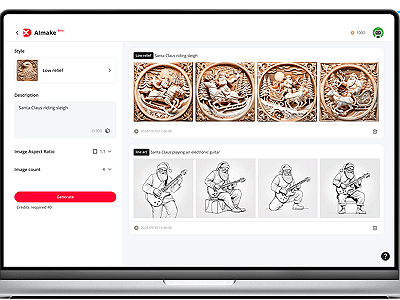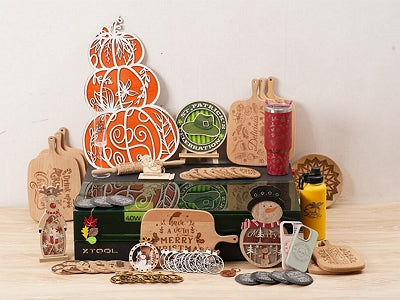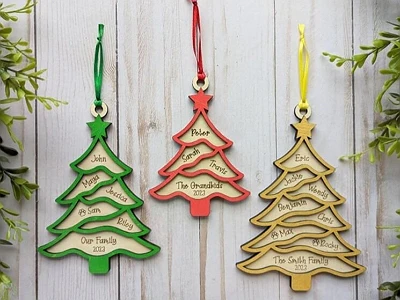How to Start a Small Jewelry Business from Home with No Experience
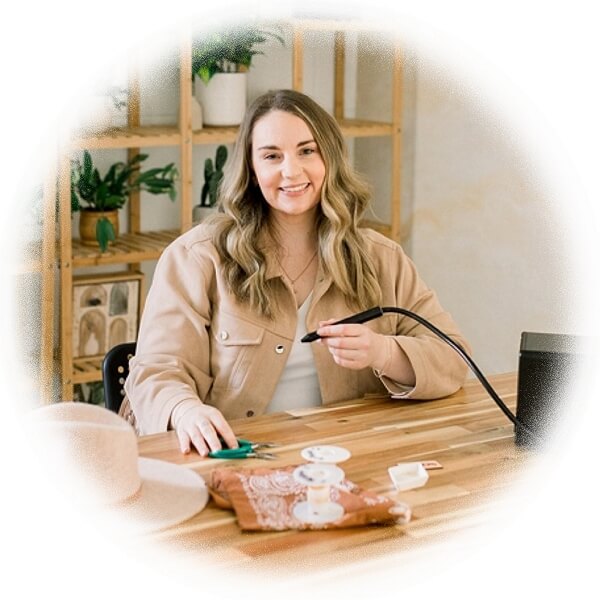
About the Author
Paige is the owner and creative mind behind Paige Barbee Jewelry. Utilizing a combination of traditional metal smithing techniques, CAD technology, and laser engraving, Paige brings her artistic vision to life in her charming store. Visit her store in Nashville, TN or online at www.paigebarbee.com.

Starting a jewelry business from the comfort of your home, even with no prior experience, is an exciting endeavor. This step-by-step guide is designed to empower you on your creative journey, providing insights, tips, and practical advice to turn your passion for jewelry making into a thriving business.
With nearly 15 years of experience in jewelry, I've spent nine of those years creating in a studio from my home. Presently, I create all our jewelry within my studio located in my retail store in Nashville, Tennessee.
Steps To Start A Jewelry Business From Home
1. Identify Your Personal Style And Niche Within The Jewelry Market
To make your jewelry stand out, you'll want to create pieces that are unique to you and your vision. Here are some tips on how to hone in on your niche in the jewelry market.
Networking with Other Crafters
Connect with fellow jewelry makers and craft business owners, either online or in local crafting communities. Engaging with others who share your interests can offer valuable insights, tips, and encouragement.
I have made some of my most valuable friendships through networking events. Connecting with fellow business owners who are in a similar stage, or slightly ahead, has been instrumental in cultivating a strong local support network as I navigate the journey of growing my business.
Identifying Inspirations
Look for sources of inspiration around you. It could be nature, art, or pop culture. Take note of what captures your attention and consider adding it to the design elements of your jewelry line.
I find that inspiration strikes when I am out doing things that I enjoy, rather than actively trying to come up with new ideas.
Reflecting on Personal Preferences
Think about your own fashion preferences and personal style. What types of jewelry do you like to wear? Your taste can help you create pieces that align with your aesthetic, making the creative process more enjoyable.
I personally gravitate toward smaller pieces that can be layered and worn every day. I've incorporated these ideas into my own jewelry collections. People can sense your passion for your own jewelry designs.
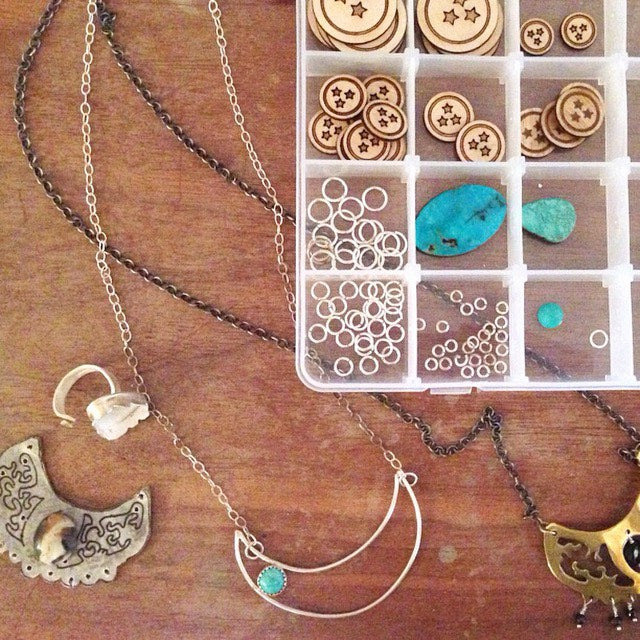
Exploration of Styles and Techniques
Once you have an idea of the style of jewelry you may want to create, start exploring the various styles and techniques used in jewelry making. Conduct research online, visit local craft shows, and attend workshops. Experiment with different materials and techniques to get a feel for what you enjoy creating.
2. Learning the Basics
The next step is the fun part – you'll begin creating jewelry! With numerous techniques and styles at your disposal, the possibilities are endless! Remember to enjoy the process and be patient with yourself—learning something new takes time to perfect.
You may want to start with a technique that is easy to master and inexpensive initially, but as your skillset grows, so can your range of jewelry offerings.
When I started my home studio, I began with a bench pin, a small butane torch, and a jeweler's saw. As I honed my style, I gradually purchased additional tools that I knew I would need in the long term.
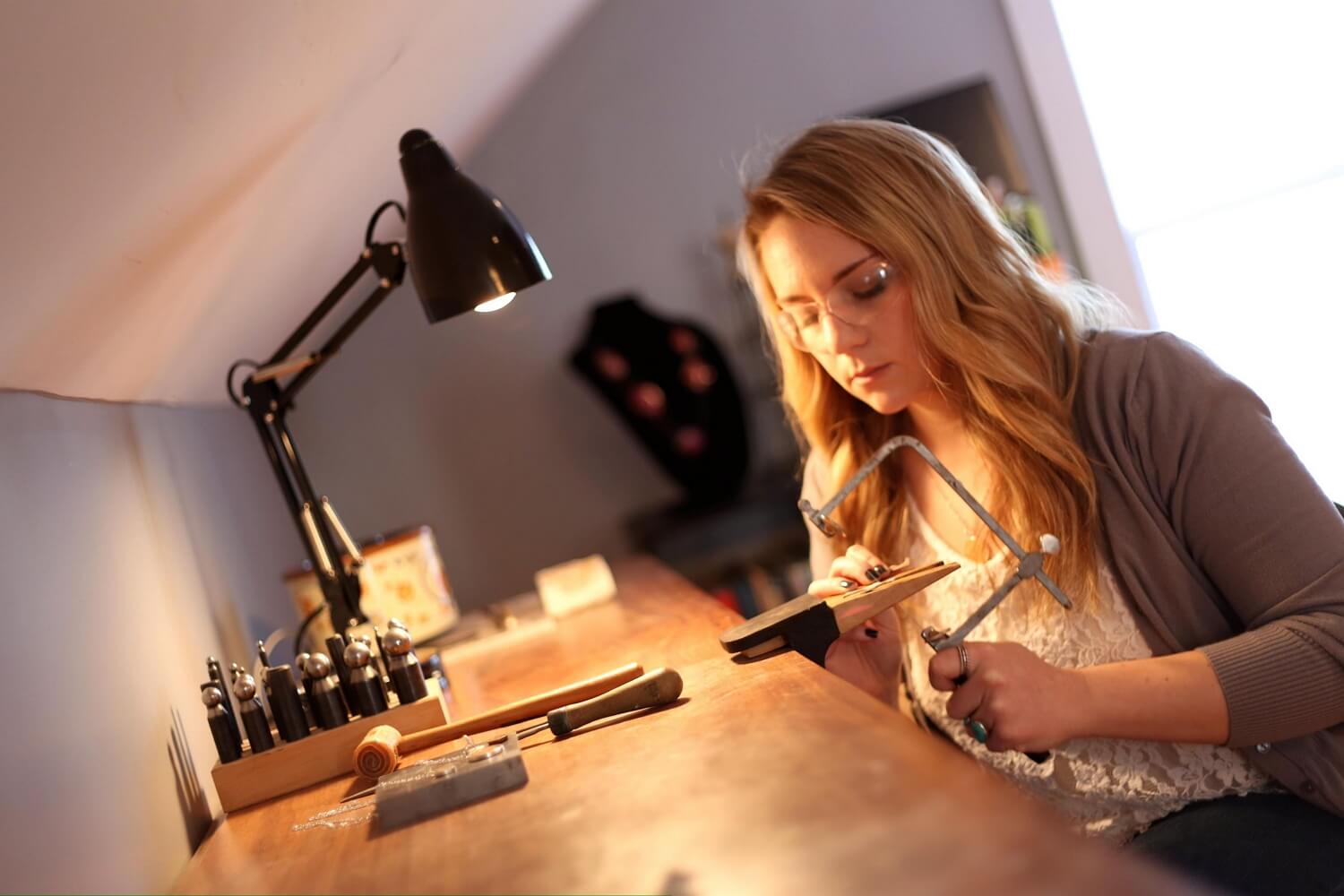
Explore Different Jewelry-Making Techniques
The possibilities truly abound when it comes to making jewelry; you can craft pieces using anything from wood and paper to silver and gold. Here are a few of our favorite techniques—experiment with different ones to find your unique style.
Wire Wrapping: Wire wrapping is a versatile technique that allows for the creation of intricate designs with minimal tools.
Stamping and Engraving: Personalize your jewelry pieces with stamping and engraving, adding a unique touch for your customers.
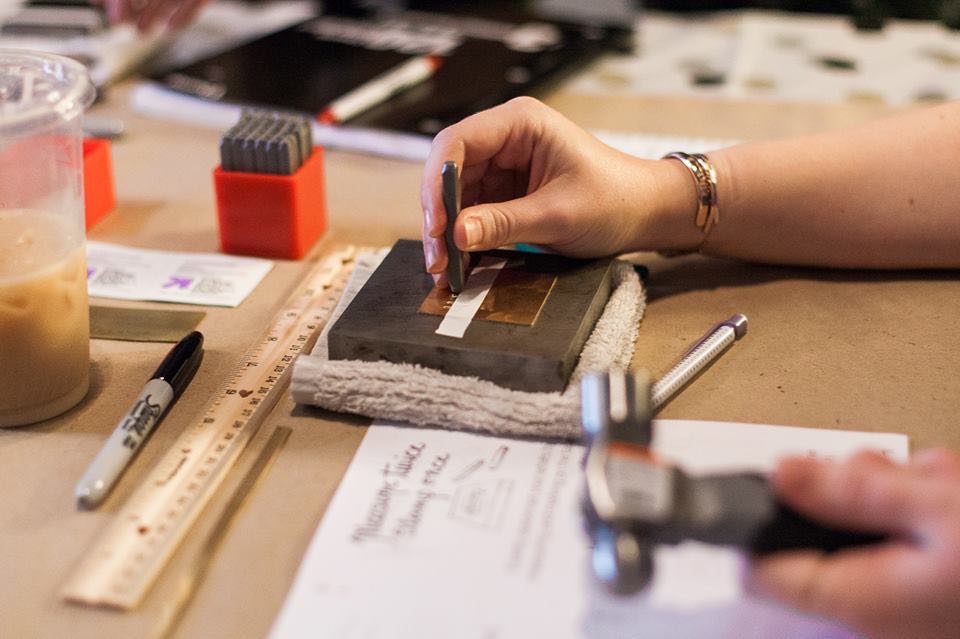
Metalsmithing: Explore basic soldering, piercing, and forming techniques for creating metal jewelry masterpieces.
Beading: Beading is a classic yet endlessly creative technique. Experiment with different bead sizes, colors, and patterns to create one-of-a-kind styles.
Resin and Polymer Clay: Experiment with encapsulating elements in resin, creating unique and personalized jewelry. Polymer clay can be shaped and molded into beautiful, colorful creations.
3. Setting Up Your Workspace
Now that you are actively building your jewelry business from home, creating an organized and functional workspace is crucial for efficiency and creativity.
Designate a Dedicated Workspace at Home
Whether you have an entire room or just a spare shelf available, establishing a dedicated space for your jewelry business is essential. This designated area will not only help you concentrate on your craft but also keep all your business-related items easily accessible.
I've had my studio set up in various places, including my living room, spare bedroom, and even the kitchen counter. You can create almost anywhere as long as you have a little space.
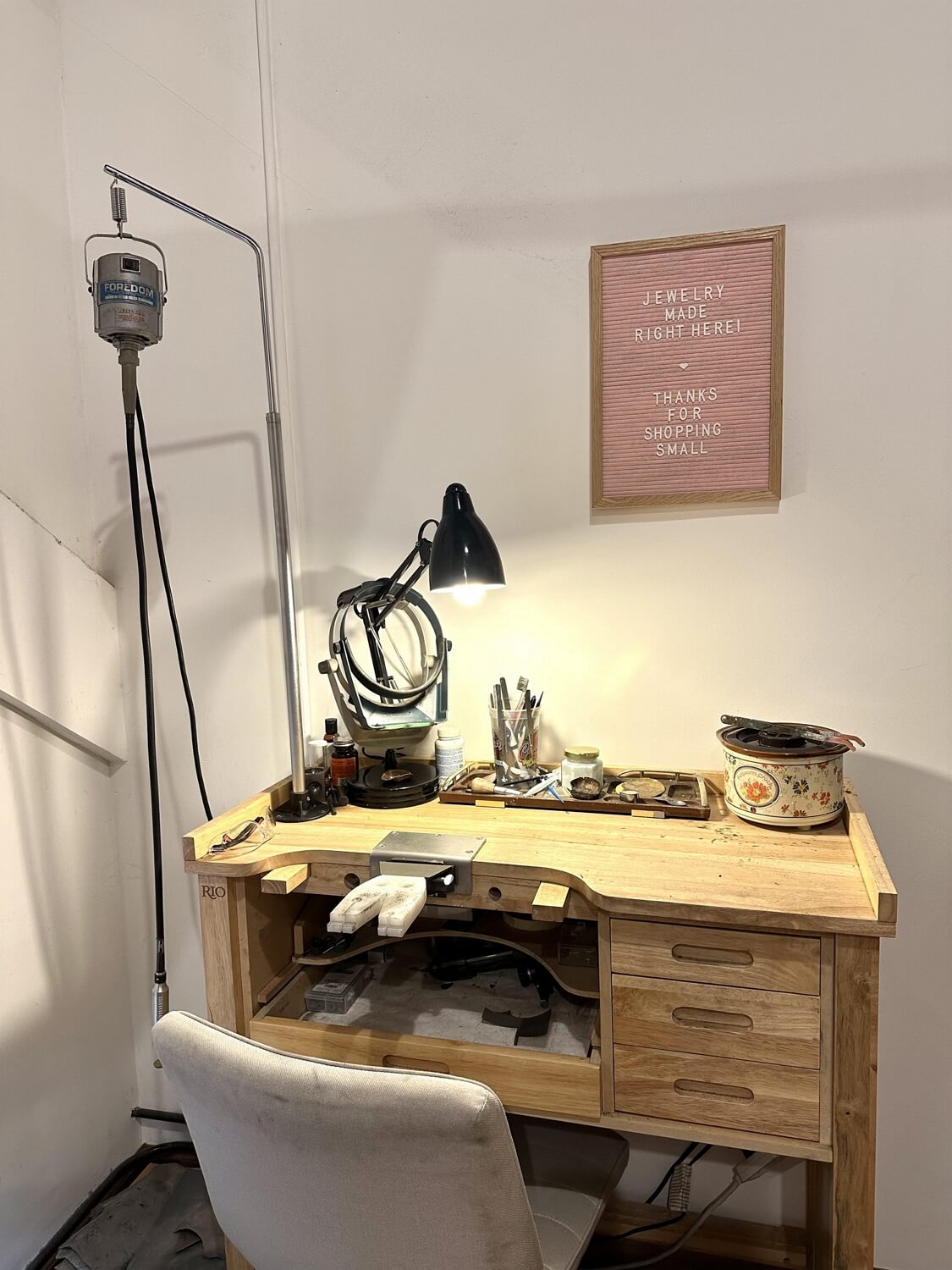
Keep Everything Organized
Maintaining an organized workspace is key to the smooth operation of your business. Ensure that all your tools, materials, and supplies have a designated place. This saves time and helps with productivity. This is particularly helpful when you can't keep your workspace set up at all times, as was the case when I used my kitchen counter. I kept all of my supplies in a box that I could bring out when needed and pack up when finished.
Invest in Tools
Now that you have a clearer vision of the jewelry you'll be creating, consider investing in tools that will assist in bringing your designs to life. Think about tools that could help you produce more items in less time, ultimately boosting your efficiency and output.
Setting up an efficient workspace not only streamlines your creative process but also contributes to the overall success of your home-based jewelry business.
4. Experiment and Refine
Now that you have identified your niche and the jewelry-making techniques you'll be using, you can begin experimenting with and refining the appearance of your jewelry collection.
Trial and Error
Practice makes perfect, embrace the trial-and-error process. Don't be afraid to make mistakes or create pieces that might not initially meet your expectations. Learning from what doesn't work is just as valuable as finding what does. This experimentation phase is crucial for discovering your unique style. Even after all these years, I am still practicing and learning to improve my craft.
Listening to Feedback
While receiving feedback, it's important to remember that not everyone may be your ideal customer. Stay true to yourself and your vision, but leverage feedback as a tool to enhance and refine your craft.
When you share your jewelry, listen to feedback from friends, family, or potential customers. Make note of which pieces receive positive responses and the reasons behind them. This provides valuable insights into what aspects of your work resonate with others.
Document the Process
Ensure you document your journey by keeping a journal. Take notes on the various processes and materials you use. This documentation will be valuable when you want to revisit and recreate pieces.
I keep a spreadsheet where I document all the designs that I recreate. In the spreadsheet, I list the item name, the various supplies needed to create it, their costs, and where I sourced the supplies.
5. Pricing Setting
Setting the right prices for your jewelry is vital for a profitable business. Understand costs, determine profit margins, research market prices, and effectively communicate the value of your jewelry to customers.
Understanding Costs
Consider everything that goes into creating a piece of jewelry; your time, materials, packaging, and tools when pricing. There are many different formulas to use to price your work, whichever you choose make sure that you are making enough money to grow the business and pay yourself.
Researching Market Prices
Once you've set prices for your jewelry, it's valuable to examine what comparable jewelry businesses are charging. This serves as a benchmark, offering insights into what potential customers may find reasonable for that specific item.
Communicating Value to Customers
Regardless of your pricing strategy, it's essential to convey the value of your jewelry to your customers.
Whether you're using premium materials or intricate techniques, sharing the story, and detailing the process behind each piece not only adds depth to your creations but also builds a meaningful connection with your customers.
I find that when executed effectively, storytelling can elevate an average design and make it highly desirable. I accomplish this primarily through my social media platforms, where I showcase behind-the-scenes processes involved in creating my jewelry designs and explain the inspiration behind each element.
6. Marketing and Sales
Today, there are numerous ways to market your jewelry business, both online and in person. Decide which platforms align best with your jewelry business and lifestyle.
I have utilized all of these strategies at one point in my business. Implement them to gauge where your customers are spending the most time.
Online Marketing
- Social Media: Share your jewelry business on social media platforms to engage current customers and attract new ones.
- Website: Establish your own website as a platform to sell your jewelry.
- Email Newsletters: Create email newsletters to inform your fans about where they can shop for your jewelry.
- Selling Platforms: Explore various online platforms to sell your jewelry, beyond your own website.
In-Person Marketing
- Networking Events: Attend local networking events to connect with others in your community and promote your business.
- Craft Shows: Apply for craft shows as they provide an opportunity not only to make sales but also to increase brand awareness. Look for shows that attract your ideal customers.
- Workshops: Host workshops to share your newfound skills and knowledge.
Jewelry Business FAQs
Is Jewelry Making A Profitable Business?
Jewelry making can be a highly profitable business, offering an opportunity to transform your creative passion into a thriving venture. Follow the above tips and practical advice to not only hone your craft but also strategically navigate the business aspects, ensuring long-term success in the jewelry industry.
Do You Need A Lot Of Money To Start A Jewelry Business?
Starting a jewelry-making business doesn't require a lot of money. Launching your jewelry business on a budget enables you to begin modestly, gradually expanding as you gain experience and establish a solid foundation for sustainable growth. I initiated my jewelry business with minimal funds and have seen it grow each year.
What Jewelry Sells Well In 2024?
COLOR - Colorful jewelry is on the rise. From gemstones to beads to enamel, everyone is looking to add a little bit of color to their jewelry collection.
SILVER - While gold jewelry has traditionally been in high demand, the popularity of silver is growing this year. Customers are seeking bold silver jewelry pieces to make a statement. Since most of my designs are in sterling silver, I'm thrilled to see its increasing popularity.
PERSONALIZATION - Customization remains a prevailing trend, as customers seek unique and personalized jewelry pieces. This can entail engraved names, special dates, or other meaningful symbols. I utilize my xTool F1 to engrave custom designs on pendants for customers at in-person events and online.


